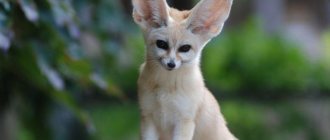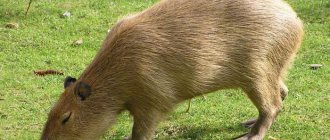Description of fennec
Fenechs are the smallest representatives of the canine family, even smaller in size than domestic cats.
The height of the chanterelle is from 18 to 22 cm, the body length is 30-40 cm, the tail length does not exceed 30 cm, and the weight does not exceed 1.5 kg. The muzzle is short, pointed in shape with large eyes. But the fennec’s ears are large, in relation to the size of the head the largest among animals, reaching 15 cm in length. The animal needs them, firstly, in order to learn from the slightest rustling in the sand about the movements of its prey (insects and small vertebrates ), and, secondly, to more effectively cool the body during the hot daytime. The fennec cat's feet are hairy, which helps him move along the hot sand. The teeth are small (especially the fangs), reminiscent of the teeth of big-eared foxes. This small animal is very jumping, capable of jumping to a height of up to 70 cm and up to 1 meter in length. — Advertising —
The fennec cat is characterized by tall, thick, delicate and soft fur with a protective color: on top it is reddish or fawn in color, on the bottom of the body it is white. The tail is fluffy, the tip is black. The “violet” supratail gland, which all foxes have, is hidden under these dark, coarse hairs. The young fennec fox is almost white.
Description of the animal
The size of this animal is smaller than that of a cat. At the same time, he has pointed facial features, huge ears, and eyes. The ears are more than 15 centimeters long.
However, this is not a disadvantage, but an advantage of the animal, since it is the ears that help it successfully hunt for prey, and in hot weather they provide heat transfer.This is a nocturnal animal with eyes adapted for darkness due to the presence of a special retina, which glows red in the dark.
The animal's fur is quite thick, slightly raised, red on top, snow-white below. The loose tail is quite dark in color at the end.
Feeding characteristics of fennec
Fenechs are omnivores; they usually dig their food directly from the sand or from the ground, and they usually hunt alone, like other foxes.
Their diet consists of small vertebrates, reptiles, small birds, eggs, insects (including locusts), carrion, plant roots and fruits. With the help of its large ears, the animal picks up the slightest noises made by its victims. It can easily live without water for quite a long time, and receives the necessary liquid from meat, berries and leaves. Tends to stockpile food. In captivity, fennec cats can be fed raw meat and a variety of live foods - locusts, small rodents, lizards, fruits and vegetables. Fermented milk and grain products, fish, and eggs are also introduced into their diet. By the behavior of a fennec cat it is easy to determine which food he likes best.
How does the fennec live?
Such a fox is characterized by activity and excessive jumping ability; in particular, it is excellent at jumping 70 centimeters in height and at least one meter forward. Simply put, the prey has no chance of survival.
The fennec animal hunts without its fellows at night, and during the daytime it hides in a hole. The underground housing, which the fennec digs quite quickly, is complex, has many exits, with the help of which you can reliably hide from enemies.
As a rule, the tunnels are dug under plants, which support the walls of the burrows with roots. Sometimes the underground labyrinths are so wide that they allow several families to live simultaneously.However, as a rule, there is nothing to be afraid of - there are practically no hunters for the animal in a desert place.
The fennec is considered an omnivore and often digs food out of the sand. The diet includes insects, lizards, and eggs. Loves carrion and root vegetables.
Feels normal for a long time without water, compensating for its lack with moisture found in food. Stocks up for future use.
Fennec cat behavior
The fennec fox is an inhabitant of sandy deserts, where it prefers to live in thickets of grass and sparse bushes, which serve the animal both as shelter and food.
It lives in minks, where there are many secret passages dug by the animal itself. Fenech is an excellent digger, capable of digging a hole up to 5 m in length overnight. The fennec cat is characterized by a nocturnal lifestyle. As social animals, fennec cats live in family groups of about 10 individuals. In such a group there is one married couple, its immature offspring, and several older cubs may also live. Sometimes such groups mix and occupy the same den. Individuals always hunt alone.
Fenech is very “talkative”: he barks, whines, grumbles and howls. He is very agile and lively, he can make high and long jumps, up to 70 cm up, but at the same time he is timid and sensitive. The protective coloration helps the animal blend into the sandy landscape, and for this reason there is no evidence of large predators hunting the fennec fox. This miniature fox has a well-developed sense of smell, hearing, and good night vision.
— Advertising —
The animal cannot tolerate low temperatures, its eyes become inflamed from the cold, colds occur, from which the animals die en masse.
What does fennec fox eat?
Under natural conditions, these chanterelles easily find food for themselves. And this is not accidental, since, despite the order to which they belong - predators - fennecs do not disdain other food. In addition to small rodents, chicks, lizards and some insects, desert fennec foxes feed on berries and plants that can be obtained in arid regions.
Fennec breeding
Fennec breeding occurs once a year.
The mating season lasts from January to February, but the females' estrus lasts only 2 days. The fennec cat is monogamous, each pair occupies its own home area. During breeding, males behave aggressively and actively mark their territory with urine. The duration of pregnancy is 50-53 days, and in March-April, females give birth to 2-6 babies. Childbirth takes place in a mink, in a nesting chamber that is lined with grass, feathers and wool. The weight of newborn cubs barely reaches 50 g. The female remains with them in the hole until they reach the age of two weeks, when the babies’ eyes open. The male brings food to the female and offspring, but does not enter the hole, since the mother drives him away from the cubs and is very aggressive. At about 5 weeks, babies leave their burrow for the first time and explore the surroundings, but only at 3 months do they begin to walk long distances on their own. By this time, their milk feeding is just ending.
Fenechs become sexually mature at 6-9 months. Sometimes they stay with their parents to help them raise new offspring.
In natural conditions, fennecs live for about 7-8 years, in captivity they even live up to 20 years.
Fennec as a pet
Having exotic pets at home is very fashionable these days. However, the domestic fennec fox is not a case where there will be no problems keeping the animal at home. Future owners should remember that these foxes are nocturnal, so sleeping with a fennec fox at your side will be problematic. In addition, foxes themselves have a pungent odor, and if they are not trained to use a litter box (which is quite difficult), then there will always be an unpleasant odor in the house. To prevent the fennec fox from causing a lot of trouble, you need to train it like a dog. But foxes are wild animals, and it takes a very long time to learn even the simplest commands.
The habit of the desert fennec fox to dig holes for itself brings many difficulties to its maintenance. You will have to purchase a large cage for the animal or even allocate an entire room. Cover the floor with a thick layer of sand to make the animal feel more comfortable.
The temperature in the apartment should be close to the air temperature in the desert, that is, higher than usual. There should be no drafts, and desert fennec foxes are sensitive to even a slight drop. At home, they often die precisely because of a common cold.
It is noteworthy that very few veterinarians will be able to advise owners about their exotic pets.
The fennec fox is friendly towards other pets, but both dogs and cats can be aggressive towards them. You should also be careful if there are small children in the house; after all, foxes are wild animals.
Interesting Fennec Facts:
- Fenech cats are often kept as pets. Their number in this role especially increased after the cartoon “Zootopia”.
- The image of a fennec cat is placed on the Algerian ¼ dinar coin.
- The fennec fox is a symbol of Tunisia's ecology. His figurine in a blue and white suit can be found everywhere, in almost every city in the country.
- Fenech can be kept in captivity, it tolerates it well and can even reproduce actively. With appropriate upbringing, the fennec becomes an affectionate and smart pet. It is not easy to maintain, but it is still quite possible to tame it.
Nutrition
The decorative fennec, like the wild one, is considered an omnivore. It is better not to give food from the table, so that in the future he does not get used to it and does not beg every time his owners eat.
Buying feed is simple. You can purchase special food for cats, their cost is quite affordable. Occasionally, live mice or insects can be given. The long-eared fennec fox will be happy with a ready-made diet consisting of porridge and meat.
The following products can be included in the dwarf chanterelle menu:
- small birds;
- eggs;
- fruits of plants;
- roots and tubers;
- raw meat;
- vegetables and fruits;
- fish.
It is important to consider that the main source of moisture for tiny chanterelles is plant food. Therefore, these products should always be available to the fennec animal.
No matter how many different animals there are, each is individual. Over time, the owner will understand which foods are the fox’s favorite foods. Based on this, it will be possible to create a tasty and nutritious diet for your long-eared pet.
Nutrition
The decorative fennec, like the wild one, is considered an omnivore. It is better not to give food from the table, so that in the future he does not get used to it and does not beg every time his owners eat.
Buying feed is simple. You can purchase special food for cats, their cost is quite affordable. Occasionally, live mice or insects can be given. The long-eared fennec fox will be happy with a ready-made diet consisting of porridge and meat.
The following products can be included in the dwarf chanterelle menu:
- small birds;
- eggs;
- fruits of plants;
- roots and tubers;
- raw meat;
- vegetables and fruits;
- fish.
It is important to consider that the main source of moisture for tiny chanterelles is plant food. Therefore, these products should always be available to the fennec animal.
No matter how many different animals there are, each is individual. Over time, the owner will understand which foods are the fox’s favorite foods. Based on this, it will be possible to create a tasty and nutritious diet for your long-eared pet.
The number of fennec cats in the wild
The status of the animal in the IUCN Red Book (rev. 3.1) is of least concern. Its numbers have never been accurately estimated. Judging by the frequency of occurrence of the beast and the number of animals caught by local residents, their number is significant, and the population is in a stable condition. About 300 fennec cats are kept in zoos around the world.
There are currently no serious reasons for a possible decline in numbers, not least because fennecs live in inaccessible and unattractive areas of Africa for development. However, the areas around the Sahara and other arid regions are beginning to be developed by humans. The construction of new roads and new settlements increases the risks for some populations of these foxes.
Additional pressure is created by geological exploration, development of oil fields and the development of commercial transport. Thus, in the area of four new settlements in southern Morocco, fennecs disappeared.
The developed road network also creates direct risks. Fennec foxes are hunted for their fur, and miniature foxes are caught by local residents for sale.
How does Fenech behave at home?
A tame fennec at home behaves friendly, playful and inquisitive. The fennec fox loves to sleep next to its owner or sit in his arms.
At home, the fennec fox is a very active animal; it searches for something almost all the time, runs around, and can easily jump onto a bedside table, sofa or computer desk. So it’s better not to leave a cup of tea or coffee near your laptop!
Fenech is very talkative: he whines, snorts, barks, grumbles and howls. Moreover, it voices not only during the day, but also at night - you need to know about this before getting such a pet.
The fennec fox won't refuse to play pranks either. For example, if he finds a bag of sugar or cereal, he will be delighted and instantly take the contents to every corner.
Please also note that all electrical wires will have to be hidden - the fenech likes to chew on them.
In the photo: fennec at home
Maintenance and breeding
It is impossible to keep a fennec cat in a small apartment. Ideally, the animal will live in a large house and a separate room will be allocated for it.
Breeding is possible. To breed offspring, a male and a female are needed. It’s worth getting used to the fact that fennec foxes constantly squeal. This is how animals communicate with each other and their owner.
Like any pet, a fox needs care and attention. He can make friends with both humans and other pets. Practice confirms that sometimes it is possible to train a fox to sleep at night and be more active during the day. Taking into account the rules of keeping, life with pets will bring only positive emotions to a person.
Providing proper nutrition to the fennec fox
Foxes are not omnivores. Some people think otherwise, but this is a harmful myth. The raccoon is an omnivore, and the fennec fox is a predator! Moreover, it is one of the rare carnivores of the Sahara. It has a weak dentofacial apparatus, similar to that of the bat-eared fox. This is due to an insectivorous diet. Of course, in the wild where an animal lives, it consumes a certain amount of plants. But for the most part, this is done because plants contain the water they need.
Thus, the home diet should include: celery, boiled sweet potatoes, various tubers and plant roots. Food of plant origin should not exceed 10% of the total diet.
The basis of the diet for the fennec cat is 90% rabbit and insects and 10% vegetables and other products. You can give other types of meat, sometimes eggs and fish, sometimes berries and fruits. Wild fennecfish, living in the desert, eat insects, lizards and rodents, but "Russian" rodents contain too much retinol. Its increased amount causes damage to the liver and kidneys. The good news is that foxes, unlike cats, can synthesize beta-carotene into retinol, so there is no need to worry about a possible deficiency.











